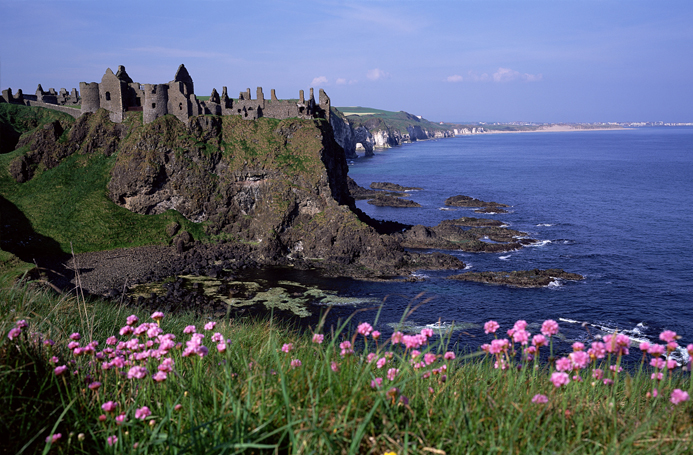
Rolling green hills dotted with obese lambs and highland cows gambolling in paddocks, low hanging clouds of purple and pink, fields of heather and barren bog land punctuated by electric green carpets of pastures and farms, and rugged promontories carved by aeons of wind and water. The Causeway Coastal drive and the Antrim coast is a visual assault trip in Northern Ireland. We claw along the coast, under archways holding up overhanging rocks and swoop down green glens in a Mercedes van listening to tales of leprechauns, Vikings and human foibles with a dash of drama from our affable Irish guide Andrew Beggs.
There are a succession of sleepy, desolate fishing hamlets and spick and span towns- each with a unique history peppered with legends of giants, ghosts and fairies. This is the land of the ice gouged valleys or the nine glens of Antrim. The characteristic U shaped valleys have given rise to the ‘ladder farms’ that we see- vertical stripes of holdings running down the slopes to the valley which give each farm an equal share of lowland pasture, hill ground and mountain grazing. This is also the land of legends. We drive past Lough Neagh, the largest freshwater lake in the British Isles which is said to have been created when the giant Fin Mc Cool lifted some land to throw at a rival giant! On Rathlin island in the distance, there’s a cave where Robert Bruce is said to have taken refuge and been inspired by a spider to return to Scotland and fight the English. And there is the Fairy Hill where fairies are said to congregate in a procession on April 30th.
The picturesque village of Carnlough and its harbour dotted with red and green boats has a piece of history: The Londonderry Arms Hotel, an old coaching inn here was once owned by Sir Winston Churchill himself. It’s an ‘Enid Blyton moment’ as we dawdle on the harbour walls. ‘Quay treats’, ‘G&M Mc Auley Butchers’ read the boards. One can almost imagine the ‘Five Find- outers’ walk round the corner. Cushendall is a town with Georgian buildings, where three glens or valleys come together in a sheltered bay. A bright mural of the local sport, hurling, one of the fastest ball games in the world, greets us here. In the distance looms Lurig Mountain, shaped like a table top. As we drive out of Cushendall, Andrew points out the dramatic, mysterious Lougharema or the Vanishing Lake which is a mud encrusted valley on a dry day and becomes a lake teeming with fish when it rains. When the lake dries the fish hide in the limestone caverns below the limestone. And of course there’s an Irish yarn! Locals say that it’s haunted by the ghost of Colonel Mc Neil and his horses who drowned here in 1888 when the water levels rose abruptly!
There is the atmospheric skeletal remains of the 17th century Dunluce castle which tethers dramatically on a rocky promontory above the jagged coast. This was the stomping ground of early Vikings and Christians. Andrew tells us that in 1639, a storm actually blew the castle’s kitchen into the sea taking with it the cooks and the evenings dinner- in a burst of typical Irish humour he calls it the world’s first ‘take away order’! Close by is the spot where the Spanish Armada ship Girona, fleeing from Sir Walter Raleigh’s fleet was ripped apart and tossed on the rocks. Across the water is a glimpse of tartan in the dark hulking form of Mull of Kintyre made famous by Paul Mc Cartney. At its nearest point Scotland is only twelve miles away. The Scottish connection is strong and many local families have Scottish surnames.
Portrush is the resort town of the district: amusement arcades, rides and seaside kitsch along with the largest number of camper holiday homes. Close by is the famous Royal Portrush Golf Club attracting top pros and celebrities: more Irish humour- the 14th hole on the side of the cliff is known as the calamity corner. A spectacular sandy beach like the arc of the moon spreads out like a Japanese fan below us-it’s the White park bay with ancient dunes and rare orchids. A few miles before the Giant’s Causeway is the rickety ‘test-your nerves’ Carrick-a-rede rope bridge connecting the mainland with Carrick Island. More than three hundred years ago, salmon fisherman swung a rope to this island which was an angler’s paradise.
The best for the last...The Giant’s causeway- a surreal, bizarre scene out of an alien planet-geometric, perfectly symmetric honeycomb of gargantuan basalt columns arranged like stepping stones. The Irish talent for spinning a yarn rears its head again and there are two explanations depending on whether you go for folklore or science! They are really the result of a pool of bubbling lava slowly cooling into 40,000 columns sixty million years ago. But the local legend goes that two rival giants, Irish Fin Mc Cool and the Scottish Benandonner taunted each other from their respective shores. Finn’s inventive wife disguised her husband as a baby and hid him in a crib. When Benandonner who was visiting saw the ‘giant baby’ he ran away to Scotland thinking that the father must be even bigger. He tore up the causeway so that Fin Mc Cool could not follow him! You can trudge up the cliff for a bird’s eye view or take a shuttle bus to the beach to see the formations up-close. There are intriguing formations with fanciful names like wishing well, Giants’ gate and even the Granny. There’s one which looks exactly like an ornate pipe organ. The Irish salt spray flattens my hair as I walk on the causeway in windswept wonderment. I can almost feel the presence of marauding mythical spirits and giants of yore here!
Published in The Hindu Metro Plus,2010.

